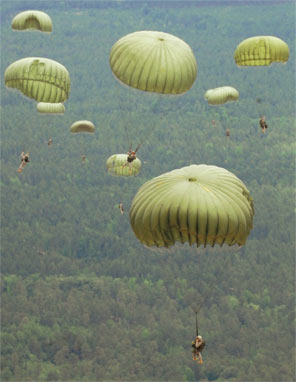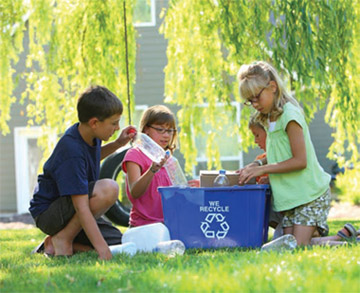Fort Bragg: Jumping into Sustainability

© Sergeant Major Kelly Luster
Many people are unaware that the traditionally conservative Southeast boasts a city of almost 300,000 that is fully committed to sustainability and whose strategic plan’s No. 1 goal is to become a Sustainable Community. In addition, this city is the co-founder of a nonprofit organization to support sustainability efforts throughout the surrounding 8-county region. Winner of numerous state, national and even White House awards for its efforts, the city’s most unique claim to fame, by many people’s standards, is that it is a United States Army Installation.
Since 2000 Fort Bragg, a premier power projection platform with troops deployed around the world, has led the way in creating a sustainable Army and a sustainable region. Located in North Carolina’s scenic Sandhills region – nestled between Raleigh, Charlotte and the popular beaches of the Outer Banks – the installation is home to a diverse array of military units, including the XVIII Airborne Corps, 82nd Airborne Division and U.S. Army Special Operations Command. These soldiers have a worldwide reputation of professionalism and mission accomplishment, thanks to their steadfast spirit and uncompromising values of loyalty, duty, respect, selfless service, honor, integrity and physical courage.
Fort Bragg’s mission is to maintain the Army’s strategic crisis response force, which is manned and trained to deploy rapidly by air, sea and land anywhere in the world and prepared to fight upon arrival and win. The phrase “18 hours to wheels up” is literal at Fort Bragg as this elevated readiness state must be maintained at all times. Training, operations, facilities, equipment and transportation are geared to support a global mission.
This “city” supports almost 300,000 soldiers, military dependents, retirees, civilian workers and on-site contractors. Like most cities its size, it boasts a modern 1,000,000 square-foot medical center, 11 shopping centers with numerous restaurants, nine schools, libraries, churches, child-care centers, its own airfield and dozens of recreational facilities. And, despite heavy utilization on its 160,000 acres of training lands, Fort Bragg protects and preserves five endangered species, including the red-cockaded woodpecker (RCW).
The future holds even more challenges for this bustling city as a result of the Base Closure and Realignment Commission (BRAC) decision to move two additional Army major commands to Fort Bragg as well as to transfer the adjacent Pope Air Force Base to Army control. By 2011 the installation will have more general officers than any other military base besides the Pentagon. To accommodate these additional units and soldiers, Fort Bragg is in the process of executing $2 billion in new construction over the next three years.
The demands of Fort Bragg’s real world mission to fight and to defend U.S. interests in conflicts around the world, combined with its rapid growth, provide unique challenges and opportunities to its sustainability vision. How did this military installation become a national leader in sustainability?
The First Sustainable Installation
In 2000 the Army recognized the need to develop innovative solutions for its environmental challenges. As such, under the direction of Raymond Fatz (then Deputy Assistant Secretary of the Army for Environment, Safety and Occupational Health), it began its search for a candidate installation to pilot these new sustainability concepts. At the time Fort Bragg certainly faced numerous challenges.

© iStockphoto.com/birdseye
Encroachment by surrounding communities along the installation’s borders significantly restricted training exercises and permanently shut down a critical drop zone. Its aging infrastructure – such as a water plant built in 1918, when “Camp Bragg” had only a few thousand residents – presented further obstacles.
“With increasingly stringent environmental laws and regulations, and public concerns about the Army’s commitment, we felt that Fort Bragg would be ideal to put sustainability in action. Fort Bragg has always been critical to the overall military mission, and sustainability seemed to be a possible solution,” said Fatz.
The Army found eager allies at Fort Bragg in Colonel (COL) Tad Davis IV, Fort Bragg’s then Garrison Commander and Fatz’s subsequent successor at the Pentagon, and Paul Wirt, Chief of the Environmental Branch. Wirt was eager to create an environmental “master plan,” and the Army’s idea to set long-range, bold goals that would help address the installation’s biggest environmental issues was exactly what he was looking for.
According to Wirt, “Fort Bragg takes great pride in never failing its mission, but we had to find a better way to incorporate environmental and community considerations to find true win-win solutions for the environment, community and mission.” Under Davis’ leadership and vision, Wirt and key Garrison staff embraced the opportunity to approach the installation’s challenges in a novel way.
After a year developing the installation’s environmental baseline, Fort Bragg’s first major milestone was to host the first-ever Army Executive Sustainability Conference in April 2001. More than 250 diverse stakeholders from stationed units, headquarters and local communities attended and were challenged to set ambitious 25-year goals that would establish Fort Bragg’s collective, long-term vision. From this collaboration emerged 10 cross-functional sustainability goals addressing ongoing challenges in air, water, solid waste, energy, transportation, green procurement, training lands and transportation. Each threatened the long-term viability of both the installation and its mission.
A critical component of a successful sustainability plan was early buy-in from leadership and key stakeholders. “We knew that we could not personally engage every person who lived and worked at Fort Bragg,” said Wirt. Thus, much of Wirt’s and his staff’s initial efforts were spent negotiating buy-in from the most influential individuals on the Garrison staff, including the installation transportation chief, master planner, engineer chief and military training officer. These individuals did not have an environmental agenda but were highly involved in the soldier support mission; therefore, they had the greatest opportunity to effect real changes.
For sustainability to work at such a large municipality, leaders had to break down functional area “stove-pipes” and to create cross-functional teams that shared a common vision in addressing mutual challenges. One of those leaders was Mike Lynch, the installation’s military training officer. Prior to sustainability, Lynch’s responsibilities – to provide the best possible training to soldiers – were often at odds with the environmental community’s oversight of the Sandhills fragile ecosystem. “When all parties finally sat down at the table together and defined the installation that we all envisioned for the future – a Fort Bragg where soldiers could actually have an even higher level of quality training in 25 years than they are able to perform now – it suddenly became much easier to find common ground in addressing our challenges,” said Lynch.

© Sergeant David Harris
With engaged, integrated sustainability teams, Sustainable Fort Bragg served as a blueprint within the next four years for what would become “The Army Strategy for the Environment.” George Carellas, one of the strategy’s primary architects while working at the Pentagon, explained: “Fort Bragg’s efforts were a key benchmark for the military in helping to define the Army’s sustainability efforts and fostering a sustainability ethic. Our goal was to deploy the lessons learned throughout the Army to strengthen its operations, enhance well-being and drive innovation. With the Army Strategy, we were better able to articulate the great things that Fort Bragg and other installations were doing in the context of a Triple Bottom Line of sustainability – Mission, Environment and Community.”
In 2005 Fort Bragg began the next major step in changing its processes and policies to ensure all 5,000-plus Garrison staff members understood the sustainability Triple Bottom Line and applied it to not only specific projects but also to day-to-day work activities. The Plans, Analysis and Integration Office (PAIO) partnered closely with Wirt and his sustainability planners to revise completely the Garrison strategic planning process to incorporate sustainability into all aspects of the Garrison’s Strategic Plan. Each Garrison activity was analyzed based on the Triple Bottom Line principles and integrated with traditional planning tools such as the Malcolm Baldrige National Quality Award criteria and the Balanced Scorecard perspectives.
This process resulted in true enterprise-wide goals – all of them with sustainability principles integrated throughout – articulating Fort Bragg’s vision of “emulating the Spirit of the Fort Bragg Soldier in the quality of our work, stewardship of our resources and commitment of our people.” Strategic Goal No.1 captures this vision perfectly by driving Fort Bragg to become “a sustainable community meeting the needs of the Soldier today, tomorrow and forever.” The Sustainable Communities’ goal is the heart and soul of the installation’s strategic plan and consists of six strategic objectives organized around the following: military training/land use, sustainable facilities, materials/commodities, utilities, transportation and people/sustainable culture. Every established objective was developed to enhance the mission, to provide for soldiers and their families, and to encourage participation of the surrounding communities.
Sustainable Sandhills
Fort Bragg recognizes that public and community involvement are critical because long-term challenges neither start nor stop at the installation boundary. Since the sustainability kick-off conference in April 2001, the military installation has focused on developing partnerships throughout the state, region and nation. These partnerships play an essential role in Fort Bragg’s sustainability success.
As an example, one of the installation’s key initiatives was formed in collaboration with the North Carolina Department of Environment and Natural Resources (NC DENR). In 2003 Fort Bragg leadership, under Davis’ guidance, partnered with the NC DENR to form the regional nonprofit known as “Sustainable Sandhills.” This landmark partnership was the first compact between an Army installation, an environmental regulatory agency and surrounding communities to work toward improving the overall regional economic and environmental conditions for better quality of life. As Davis stated, “If we all work together, we can make the region surrounding Fort Bragg one of the most sustainable places to live and to work in America, for both current and future residents of the Sandhills.”
William Ross, Jr., Secretary of NC DENR in 2003, had similar thoughts: “It’s our challenge to remember that what we are setting out to accomplish is important. It will be hard – there is no other choice – and through cooperation we can find the right route to bring a higher quality of life to the region.”

© iStockphoto.com/morganI
“The support of the Army has enabled Sustainable Sandhills to engage local governments and nonprofits and, most importantly, the residents and businesses of the region in a grassroots effort to create sustainable communities around Fort Bragg,” stated Jon Parsons, Executive Director of Sustainable Sandhills. Examples of Sustainable Sandhills’ programs include city-wide recycling programs, green school and business initiatives, an “urban farm” tour and the creation of a network of greenways and trails. (For more information about Sustainable Sandhills, please visit http://sustainablesandhills.org.)
The Army, Sustainable Fort Bragg and Sustainable Sandhills are dedicated to improving the quality of life in the Sandhills communities’ region. The ongoing partnership has led to multiple roundtable workshops with key regional partners to ensure sustainability is incorporated in a way that guarantees a sustainable Fort Bragg and region. Buy-in on this level gives the military a unique opportunity to stand with community planners and developers to present the needs of the installation and to include the importance of mission readiness while ensuring the communities have productive futures as well.
Leading the Way
Fort Bragg is a cornerstone in promoting sustainable behavior in the Army, in other military services and in North Carolina. Its original sustainability planning process has been fielded at more than 25 other installations worldwide and institutionalized as part of Installation Management Command’s strategic planning process. The Department of the Army intends to systematically field this process to additional installations each year. In addition, NASA adopted and adapted the Army model at 13 of its Space Centers during 2007 to determine risks to on-going missions. The Air Force Space Command is also evaluating the Army’s sustainability planning process for potential application.
The success of Fort Bragg’s program has been recognized with numerous local and national awards. In 2003 and 2004 Fort Bragg and Sustainable Sandhills consecutively won the first two Sustainable North Carolina Awards. In 2004 and 2008 Fort Bragg was recognized with the White House Closing the Circle award for its sustainability initiatives. In 2008 Fort Bragg swept the first Secretary of the Army Sustainability Awards by winning both the installation and individual categories. The installation award focused on Fort Bragg’s innovative, integrated sustainability program and its significant contribution to Army sustainability while the individual award recognized Wirt for his vision and passion in guiding the program from inception to the standard accepted throughout the Army.
“Fort Bragg has been the Army’s leader within the past eight years in the drive to become a sustainable installation and to integrate the Triple Bottom Line into all facets of our Garrison operation. The commitment of our Garrison leadership to build strong cross-functional ownership of our strategic plan is what makes Fort Bragg unique,” explains Wirt.
Influencing Change

© iStockphoto.com/davidhills
Wirt is not alone in his belief that the Army can truly be a sustainability model for the rest of the country. After leaving the Pentagon, Raymond Fatz became President and CEO of Plexus Scientific Corporation and was later joined by George Carellas (former DOD Regional Environmental Coordinator for Region 4) and other Pentagon visionaries who wanted to continue their sustainability work. “It is incredibly rewarding to see how far the Army has come in the last decade by taking advantage of opportunities to influence change positively,” declared Fatz.
Wirt agrees, “The ripple effects of the Army’s efforts can truly help to create a cultural change that will secure a better future for the next generation.”
The city of Fort Bragg has faced many challenges along its path to becoming sustainable – and will likely face many more to come – but there is no denying the valuable lessons its journey provides to other cities and corporations seeking a balance between the overall mission, economic drivers, environmental concerns and the community-at-large. This forward-thinking military installation’s Environmental Management System policy statement says it all: “Sustainable Fort Bragg . . . securing the legacy of Fort Bragg for Soldiers, families and the community . . . The Right Way . . . The Green Way . . . All The Way!”




























